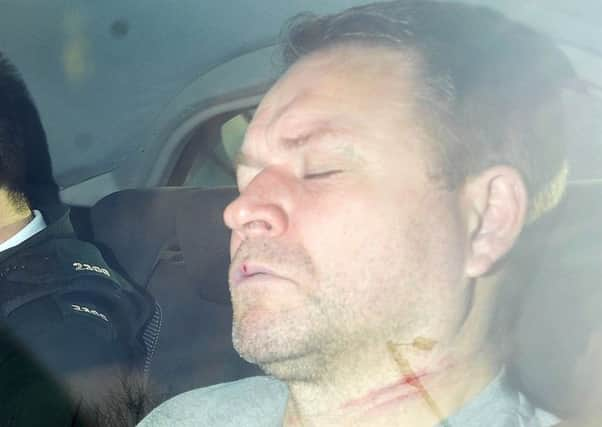Pathologist: Fatal wound to Anita's neck not caused by accident


Ms Downey, a 51-year old mother-of-three, died from a large wound to the left side of her neck which was so deep it reached her cervical spine.
Her partner David Lyness is currently standing trial at Belfast Crown Court for murdering Ms Downey in the living room of his Toberhewny Hall home in the early hours of January 20 last year.
Advertisement
Hide AdAdvertisement
Hide AdThe 52-year old Lurgan man has denied the offence, and claimed the fatal wound to Ms Downey’s neck was sustained during a struggle when tried to take a knife off her. He also claimed that after she died, he firstly tried to take his own life with the same knife, then lay beside her and cuddled her until police arrived.
The jury heard the kitchen knife totals 33cms in length, with a 20cm pointed blade. Lyness described it as a chef’s knife and said he bought it in TK Maxx for £6.99.
As the trial entered its second week, the assistant state pathologist for Northern Ireland who carried out an autopsy on Ms Downey’s remains on January 21 told the court death was due to an incised wound to the neck.
Revealing Ms Downey was an otherwise healthy woman, the pathologist said that as well as the fatal wound to her neck and throat area, the deceased also displayed several ‘blunt force injuries’ on her face and neck which resulted in bruising.
Advertisement
Hide AdAdvertisement
Hide AdWhen the doctor was asked about the fatal stab wound by Crown prosecutor Neil Connor QC, he told the jury the lower edge of the “gaping wound” measured 15 cms from side to side. And when asked what damage this had done to the underlying structure of the neck, the pathologist said it had “completely severed” the thick neck muscle used to turn the head, as well as partially severing her left jugular vein. He also revealed there was a cut to the cervical spine bone.
The pathologist was also asked about a wound to Ms Downey’s upper left shoulder, and when questioned about when and how this could have occurred, he said: “She may have raised her shoulder up whilst the blade was being passed across her neck.”
Also present were physical signs which the doctor said suggested her neck has been gripped prior to the knife wound.
From the witness box, the pathologist said death was caused by severing the jugular vein which would have caused “copius bleeding”, adding this wound was caused by “more than one movement of the blade across the neck”, which he said “would be in keeping” with a sawing motion.
Advertisement
Hide AdAdvertisement
Hide AdMr Connor QC then asked the pathologist what kind of force would have been used to produce such a wound, to which he replied “at least moderate force was used.” He was then asked how long it would have taken Ms Downey to die, and he responded by saying that due to the size of the wound, death would have been “a small number of minutes”.
When asked to comment upon the level of alcohol in Ms Downey’s system, the pathologist told the court: “The notable drunkenness may have reduced her ability to defend herself from the attack.”
Mr Connor then asked the pathologist whether or not the deceased could have caused the fatal neck wound herself, accidentally. He replied by saying “I don’t think that the pathology appearances are in keeping with an accident. You couldn’t get a wound like that simply as the result of an accident. There were at least two cuts to the neck.”
Under cross-examination by Richard Green QC, the barrister representing Lyness, the pathologist was again asked whether or not the fatal wound was inflicted by accident.
Advertisement
Hide AdAdvertisement
Hide AdRevealing it was his client’s case that Ms Downey sustained the injury during a struggle as Lyness tried to take the knife off her, the pathologist said: “No. This injury is indicative of there being more than one cut across the neck, as if somebody has cut her throat.”
Asked why this wound couldn’t have been caused during a struggle, the doctor said that even if they both ended up on the floor, the only way the wound she sustained could have been caused was by “somebody taking a knife and cutting her throat with it ... you don’t get injuries like this just by falling on a knife.”
In addition to evidence from the pathologist, the jury of seven men and five women also heard Lyness’s version of events following his arrest.
In the aftermath of Mr Downey’s death, Lyness was taken to Musgrave Street police station, where he denied killing his partner. Instead, he made the case that whilst listening to music and drinking, Ms Downey’s mood changed and that she came at him with a knife. He claimed he jumped up from a chair, and grappled with her as tried to disarm her and that she sustained the wound in the “frantic scuffle.”
Advertisement
Hide AdAdvertisement
Hide AdTelling police “Anita was really drunk, I was fairly drunk”, Lyness told police that after the pair become embroiled in a struggle, they both ended up on the floor. He said they “wrestled,” as he was trying to get the knife from her “for my own safety and for her safety as well”, he “just noticed an awful lot of blood, then I realised something terrible had happened.”
Lyness said he shouted for his son to call an ambulance, that he “stayed with Anita and then she stopped breathing”, then he “lay down beside Anita and stayed there until the police came ... I just lay beside her and hugged her.”
At hearing.